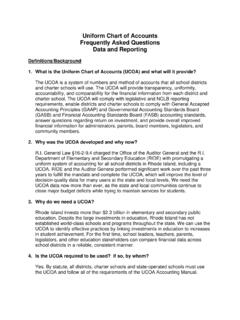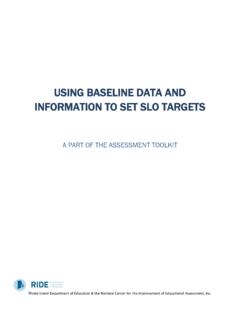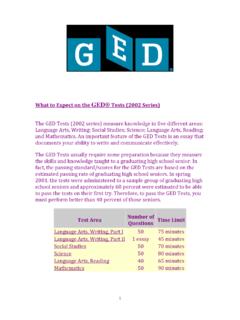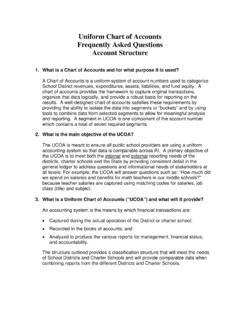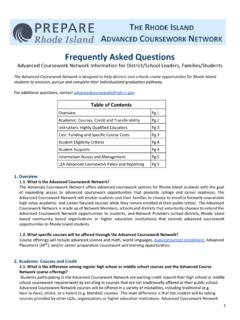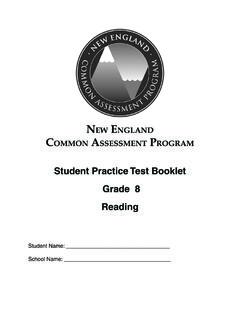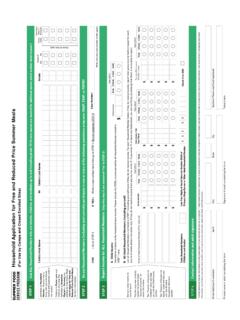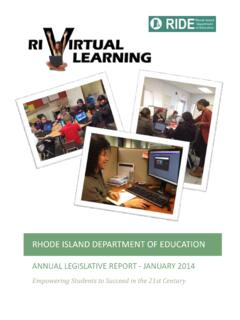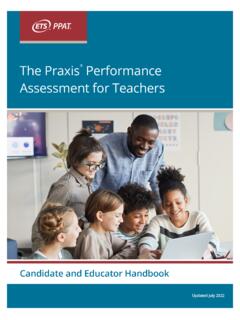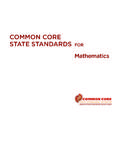Transcription of Student Work Analysis Protocol - Rhode Island
1 Student work Analysis Protocol A PART OF THE ASSESSMENT TOOLKIT. Rhode Island Department of Education & the National Center for the Improvement of Educational Assessment, Inc. Page |2. Overview The Student work Analysis Protocol presented here provides a process that groups of educators can use to discuss and analyze Student work . It is intended to be applicable across subjects and grades, including literacy, mathematics, science, the arts, and others. Examples of Student work that can be used as practice for analyzing are included as appendices. Analyzing Student work gives educators information about students ' understanding of concepts and skills and can help them make instructional decisions for improving Student learning.
2 The success of this process is dependent on a culture in which all educators are collaborative and focused on reflective practice to improve Student learning. Contents Overview .. 2. Terminology .. 3. Why Analyze Student work ? .. 3. Formative Analysis of Student work .. 4. Student work Analysis Process .. 4. Student work Analysis Protocol .. 6. Bibliography .. 9. Page |3. Terminology The following provides a clarification of some of the terms used in this document: Assessment an instrument or process for documenting in measurable terms what students know and can do. Educational assessments can take many forms, including but not limited to, written tests and assignments, performance tasks, and portfolios.
3 Educator indicates those individuals who are analyzing Student work during a Student work Analysis session. This can include a classroom teacher, content area teacher, administrator, special education teacher, and specialists (reading, media, speech pathologists, etc.). Protocol a vehicle for building the skills and culture necessary for collaborative work . It can help to ensure equity and parity thus allowing groups to build trust by actually doing substantive work together. Protocols create a structure for asking and responding to challenging questions, reflecting on an issue or dilemma, and gaining differing perspectives and new insights. Student work the Student 's response to the task. Task refers to any assignment that requires a response from students .
4 This may be in the form of a constructed response, problem solving, or performance. Why Analyze Student work ? Engaging in a collaborative process of looking at Student work allows a group of educators to analyze the learning experiences they have designed for their students and determine their effectiveness. When teachers collaboratively analyze Student work they can build understanding and agreement about the consistent use and interpretation of a rubric with the goal of improving Student learning. This process encourages teachers to consider: What are my students ' strengths with regard to the required knowledge and skills? What are my students ' learning needs with regard to the required knowledge and skills?
5 Do students have sufficient foundational content and process skills to approach new learning? How can I support Student learning through scaffolding and differentiation? The most important benefit of analyzing Student work is improved Student learning. According to Langer, Colton, and Goff (2003), the most important benefit of collaboratively analyzing Student learning is that at-risk students learn more. In addition, through a Student work Analysis , students and teachers have increased clarity about intended outcomes. Other benefits for teachers and educational organizations that have been identified include: Increased professional knowledge about curriculum, students , methods, strategies, assessments, and contextual factors.
6 Page |4. Greater understanding of alignment among standards, curriculum, instruction and assessments and how to fill gaps for students , as well as how to assess based on instructional expectations. Positive opportunities to collaboratively share expertise and move away from isolated teaching. Higher consistency of curriculum alignment within and across grade levels are established. School improvement goals and resource allocation are driven by classroom data. Professional development planning is targeted to teachers' needs based on Student evidence. A collaborative culture of inquiry about Student success is developed. Formative Analysis of Student work Formative Analysis of Student work through a collaborative process allows teachers to discuss what different levels of Student work look like, identify possible explanations for students '.
7 Performances, and discuss options for adjusting and strengthening instruction. In addition, when setting targets for Student Learning Objectives, knowing students ' starting points enables teachers and administrators to approximate the amount of progress that students should make during the interval of instruction. One way to organize baseline data is to identify three levels of preparedness for the curricular focus of the Objective Statement: students have not mastered pre-requisite knowledge Low or skills necessary for the course students are appropriately prepared to meet the Expected demands of the course students have already mastered some key knowledge High and skills Of course, in any given classroom there may be many, few, or no students in each of these categories.
8 The use of the Analysis of Student work Protocol will help determine the levels of preparedness both as baseline information, as well as to monitor Student progress throughout the interval of Student work Analysis Process During the Student work Analysis process, educators begin by gaining clarity around the expectations for Student performance on a task and its corresponding rubric2. The facilitator will ask questions to assist the team in understanding what is being assessed and in reaching consensus on what constitutes a proficient response. Without scoring, teachers do a quick 1. For more information on baseline data and setting SLO targets see: Using Baseline Data and Information to Set SLO Targets: A Part of the Assessment Toolkit, 2.
9 If a rubric is not available, an effort should be made to create an applicable rubric for scoring the Student work before undertaking the Student work Analysis process or attempting to score the Student work . Page |5. sort of students ' work by overall degree of objectives met, partially met, or not met. Teachers may also need to create a not sure pile. After the quick sort, the papers that were in the not sure pile should be matched with the papers in one of the existing piles. Once the papers are sorted, a few samples from each level (low, expected, high) are reviewed and the prerequisite knowledge that students have acquired based on the assessment are discussed and recorded. Misconceptions or wrong information are also discussed and recorded.
10 Finally, the team considers the learning needs for the class overall, noting patterns and trends, as well as the learning needs for each targeted group. These are recorded with the intent of acting upon them. Page |6. Student work Analysis Protocol3. Subject Area: _____ Grade Level: _____. Formative or Performance Task: _____. A. Reaching Consensus about Proficiency Read the assessment prompt and/or rubric and explain: What are the students expected to do? Which standards (CCSS or content standards) or curriculum expectations are being assessed? What do you consider to be a proficient response on this assessment? Exactly what do students need to say or write for you to consider their work proficient?
